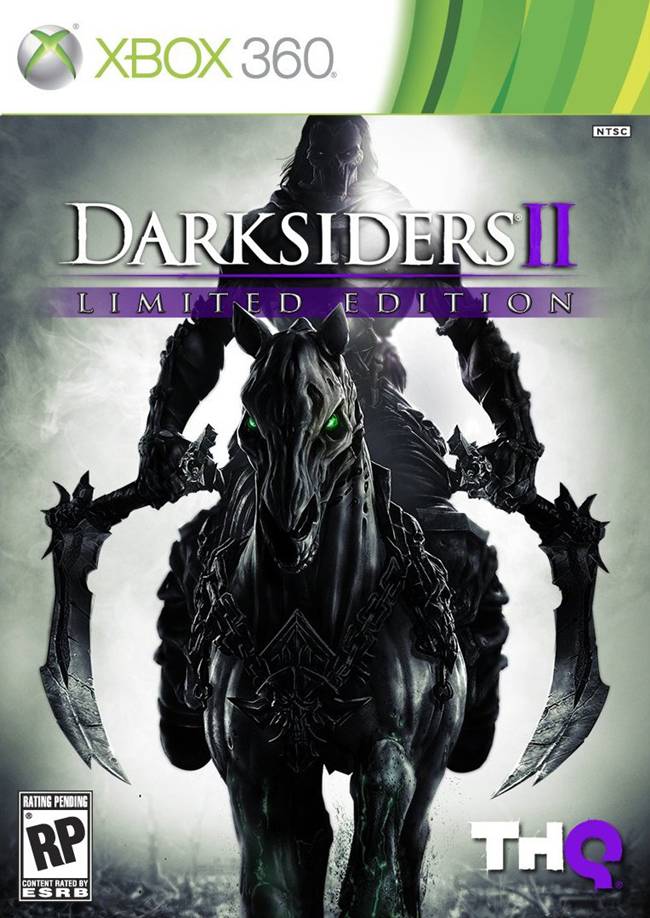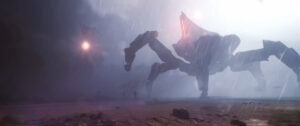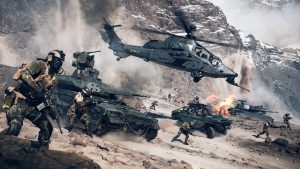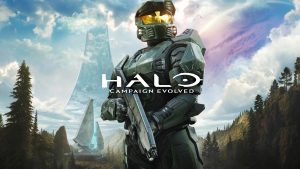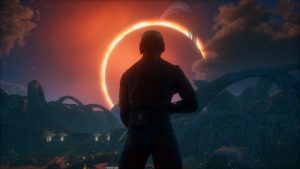What happens when you take a pinch of God of War, a dash of Zelda and a heaped tablespoon of colourful madness? Well you get Darksiders, of course, Vigil Games’ surprise success of 2010, which saw one of the four horsemen, War, inadvertently doom all mankind by prematurely starting the apocalypse.
In true mythological fashion, Darksiders II pits you as Death, War’s sullen brother, in an attempt to clear War’s name and we headed to THQ to play several hours and chat visuals with Vigil Games’ art director Han Randhawa. Forget the cloak and dagger, the Death we see in Darksiders II looks more like Conan the Barbarian with hypothermia.
For the most part, that’s how Death comes across, and it’s a shame he never seems to be characterised fully. He hovers in the middle-ground between dark, yet likeable anti-hero and misterstood softie, rendering him frequently dull and unlikable, like the spoilt only-child of the nouveau riche. Not every character needs to be Ethan Mars or Andrew Ryan, but when it comes to plot points it’s difficult to even begin to care about Death’s plight and goals, merely serving as a means to slash up some more creatures.
One of the biggest and most highly praised facets of the first game was the combat, being fluid, visceral and most importantly fun. The most striking thing about Darksiders II is just how simple the combat is, many combos require just the use of the ‘light attack’, without the need to memorise a moves-list as long as your arm. Instantly you begin to enjoy yourself and the more you do, the more you realise how expansive the combat can become. Especially when it comes to dodges, as well as allowing the player to evade it also acts as an attack modifier, attacks which are unlocked as you progress.
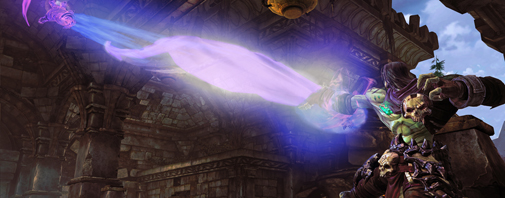 Platforming also carries this inherent simplicity to it, also serving as one of the game’s strongpoints. It’s essentially the same as the Uncharted system, only with a crucial difference, Darksiders II employs the use of a ‘lean’ button, meaning traversing over to objects behind you feels more intuitive, rather than simply waggling the left stick in its general direction. Much of this is due to the solid level design, the puzzle-elements are largely built into the environment itself, save for a couple of ‘ball’ based tricks, accentuated by the excellent use of your crow companion Dust.
Platforming also carries this inherent simplicity to it, also serving as one of the game’s strongpoints. It’s essentially the same as the Uncharted system, only with a crucial difference, Darksiders II employs the use of a ‘lean’ button, meaning traversing over to objects behind you feels more intuitive, rather than simply waggling the left stick in its general direction. Much of this is due to the solid level design, the puzzle-elements are largely built into the environment itself, save for a couple of ‘ball’ based tricks, accentuated by the excellent use of your crow companion Dust.
Many games seem to value direction over immersion, slapping a great big arrow, inexplicable hovering line or a chattery dim-witted companion to squawk you towards the level goal, but Darksiders II is different. Dust is silent upon summoning, will fly towards your goal and perch himself upon a nearby branch, stoically waiting for you to catch up. It’s simple, but serves as a great way to refrain from reminding you that you’re playing a game, a nice touch to say the least.
Death is the embodiment of the Darksiders ethos, from his ridiculously exaggerated proportions and comically over-sized weapons, to his surprisingly colourful appearance, it almost gives the game an anime-as-done-by-the-West feel to it.
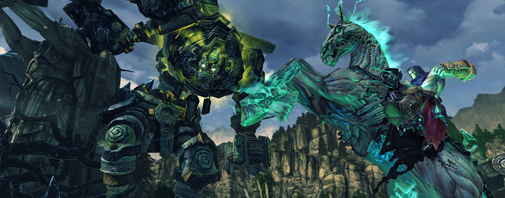 It’s clear Darksiders II has taken the look and feel of the first game, and accentuated it into something better, Han said much of this was to do with the setting: “Our creative director, who is of course Joe Mad, his focus has always been the characters so we really wanted to use their style to reflect back into the environment and that was a real visual push for us on Darksiders II.”
It’s clear Darksiders II has taken the look and feel of the first game, and accentuated it into something better, Han said much of this was to do with the setting: “Our creative director, who is of course Joe Mad, his focus has always been the characters so we really wanted to use their style to reflect back into the environment and that was a real visual push for us on Darksiders II.”
“Joe [Mad] draws, these large-proportioned characters with these big hands and arms, with a kind of anime influence in there as well, the stances, poses and animation are all about ‘attitude’. We’ve transferred that sense of attitude and style language into the buildings and really, when you distill it down, it’s about strong silhouettes. We don’t deal with too many ‘fiddly bits’, everything is kind of chunky and has an edge quality to it, where it’s been squared off or faceted, along with the more rounded elements. “
These elements are never more obvious than when it comes to the Makers, the embodiment of Han’s phrase “strong sihouettes”. This race can only be described as giant dwarves, towering over Death himself, who would prove to be intimidating if they weren’t such a friendly bunch.
 “That’s the kind of paradox that’s there because they literally are giant dwarves, but we pushed a real celtic and nordic theme with them. The idea behind those guys is that, if you recall in Darksiders 1, there was a character called Oltaine, he was a Maker in exile, and he was a popular character, so we wanted to go back and see more of his people, their culture. They’re very much in touch with Earth, a dying race, the last of their kind. They’re called the Makers as they were the master craftsmen of the world, having built the White City, Eden, very important places in the game were crafted by their hand, but also artifacts like the Seven Seals. Only a Maker could do something as powerful as that.”
“That’s the kind of paradox that’s there because they literally are giant dwarves, but we pushed a real celtic and nordic theme with them. The idea behind those guys is that, if you recall in Darksiders 1, there was a character called Oltaine, he was a Maker in exile, and he was a popular character, so we wanted to go back and see more of his people, their culture. They’re very much in touch with Earth, a dying race, the last of their kind. They’re called the Makers as they were the master craftsmen of the world, having built the White City, Eden, very important places in the game were crafted by their hand, but also artifacts like the Seven Seals. Only a Maker could do something as powerful as that.”
Initially the visuals can present as being a tad underwhelming, the first area being an ice kingdom, ruled over by the rather odd looking Crowfather. The entire area is full of rich blues and whites, yet occasionally let down by some frankly terrible texture issues. In parts the landscape looks almost cel-shaded, not through any particular stylistic choice, but portions low-resolution, especially odd when you consider how heavily weighted the visuals are in a game like Darksiders.
As you progress through into new areas, a real sense of personality is built up between them. Each area feels distinctly different, and that was only in four areas visited during a two-hour playthrough. Not only that, but each location has clearly been designed with a primary colour in mind, each reflective of the area itself, its tone and wellbeing and those who inhabit it.
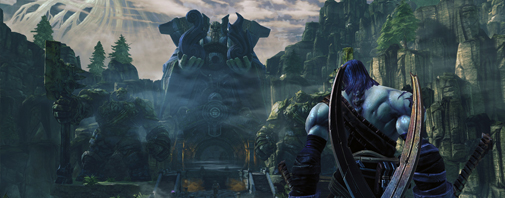 Han told us about the ethos behind the Makers’ area and the sense of balance in Darksiders II: “There’s a beauty you can see which once existed in the Makers area, but it’s almost like autumn is happening, akin to the Lothlórien in Lord of the Rings, there is definitely a sense of things coming to a close.“
Han told us about the ethos behind the Makers’ area and the sense of balance in Darksiders II: “There’s a beauty you can see which once existed in the Makers area, but it’s almost like autumn is happening, akin to the Lothlórien in Lord of the Rings, there is definitely a sense of things coming to a close.“
“The Maker’s area also leads me on to the sense of balance in the whole game. We’re talking about light and dark, life and death and the Horseman are trusted to maintain the balance by the Charred Council. They’re the last of the Nephalim, a very powerful race born of angels and demons, in the story you’ll find they were also responsible for destroying their own race, they wanted to inherit earth and became out of control. The sense of balance is also reflected in the locations’ The Makers’ area is a ‘life’ area, same with the angelic area, the demon and dead planes which are the darker, ‘death’ areas so to speak, and the visuals reflect that.“
When you pass through towards the Fjord, the colour shifts again, becoming almost monochrome save for a few sparse patches of green. This portion is reminiscent of the style we see in games like The Saboteur or Flower, the absence of colour being indicative of a present evil.
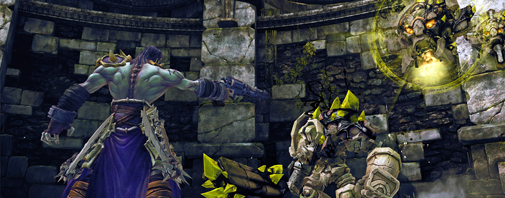 It’s clear these choices are intentional, as Han explained to us: “These are the places where Corruption is the strongest, you can see it’s sucked the life out of that area. I believe you can tell a story through light, shadow and those elements. If you can get a sense of the mood of a place you can partway tell the story. “
It’s clear these choices are intentional, as Han explained to us: “These are the places where Corruption is the strongest, you can see it’s sucked the life out of that area. I believe you can tell a story through light, shadow and those elements. If you can get a sense of the mood of a place you can partway tell the story. “
“For us as consumers of visuals and players of games, we need that contrast to stimulate us. From dark and light, stark and lush, so players don’t get a sense of fatigue. Something we talk about is the ‘next-gen grey’, a common thing attributed to next gen games is the use of a solitary palette and we’re getting that a lot.“
It’s clear Darksiders II is about the look, feel and sense of attitude, it’s strengths lying very much in the gameplay with visual style coming a close second. Darksiders has carved itself a unique visual signature, with a rich environment to create an excellent fantasy world. It’s certainly a fun game that’ll more than serve its purpose, but there’s a real possibility that few gamers may see it through to the end with such a disaffecting storyline. That’s not to say the story is inherently bad, but when a 25 hour long game fails to really engage the gamer in its story from the off, one wonders if it can simply rely on gameplay alone.








